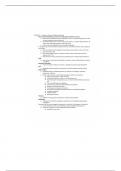CHAPTER 11 – Substance Abuse and Addictive Disorders
- Many consumed substances cause harm or disruption to behavior or mood
o Overall cost of substance misuse is $740 billion in the U.S. along (combing costs of crime,
lost work productivity, and health care)
o 135 million people in the U.S. have used cocaine, heroin, or another illegal substance; 32
million have used illegal substances with past month
o One-quarter of all teenagers have used an illegal substance
- In any given year, 7.4% of all teens and adults in the U.S. more than 20 million, have a substance
use disorder
o American Indians have the highest rate of substance use disorders in the U.S. (10.1%)
o Asian Americans: 4.8%
o Non-hispanic white Americans, Hispanic Americans, African Americans have rates
between 6.9%-7.7%
o Only 18.4% of all those with SUD receive treatment from a mental health professional
- Drug
o Any substance other than food affecting our bodies or minds, including alcohol, tobacco,
and caffeine
- Substance intoxication
o Cluster of changes in behavior, emotion, or thought caused by substances (DSM-5)
- SUD
o Maladaptive behavior patterns and reactions caused by repeated substance abuse
- SUD: Checklist
o Individual displays a maladaptive pattern of substance use leading to significant
impairment or distress
o Presence de of at least 2 of the following symptoms within a 1-year period
Substance often taken in larger amounts
Unsuccessful efforts to reduce or control substance use
Much time spent trying to obtain, use, or recover from the effects of substance
use
Failure to fulfill major role obligations
Continued use despite persistent interpersonal problems
Reduction of important activities
Continuing use in dangerous situations
Continued use despite worsening of physical or psychological problems
Craving for substance
Tolerance effects
Withdrawal reactions
- Tolerance
o Need for increasing doses of substances to produce desired effect
- Withdrawal
o Unpleasant and sometimes dangerous symptoms occurring weigh drug stopping or
cutting back
- Substances fall into several categories: depressants, stimulants, hallucinogens, and cannabis
o Can be ingested in various ways (inhaling, snorting, swallowing, injecting, etc.)
o Each form of ingestion can pose significant physical problems
Especially chronic users
, Depressants
- Slow the activity of the CNS
o Reduce tension and inhibitions
o May interfere with judgment, motor activity, and concentrations
- Most widely used depressants
o Alcohol
o Sedative-hypnotic drug
o Opioids
- Alcohol
o 2 billion people worldwide consume alcohol
o More than half in the U.S. drink alcoholic beverages
o All alcoholic beverages contain ethyl alcohol
Absorbed into the blood through the stomach lining
Takes effect in bloodstream and CNS
o Extent of the effect of ethyl alcohol is determined by its concentration (proportion) in
the blood; intoxication = 0.09%
o Level of impairment is closely tied to the concentration of ethyl alcohol in the blood
o Effects of alcohol subside only after alcohol is metabolized by the liver
o Alcohol increases the activity of the neurotransmitter GABA at key sites in the brain
o Gender affects blood alcohol concentration
Women feel affect stronger/faster than men
- Alcohol use
o Middle schoolers: 25% report some use
o High school seniors: 29% drink monthly; 2% drink daily
o College students: 38% engage in monthly binge drinking
- Alcohol use disorder (AUD/Alcoholism)
o U.S. population older than 11 years: 5.4%
o Teenagers: 2.3%
o Men vs. women: 2:1
o Ethnic differences
o Clinical picture
Regular consumption and reliance affects cognition, social life, and work
behaviors
Individual alcoholism patterns vary
Damage in various structures of the brain and, correspondingly, impairments in
memory, speed of drinking, attention skills, and balance found in chronic heavy
drinkers
o Tolerance and withdrawal
Tolerance increases consumption levels
Variety of negative withdrawal symptoms
Delirium tremens (DTs)
- What are the personal and social impacts of alcoholism?
o Alcoholism destroys families, social relationships, and careers
Alcohol plays a role in suicides, homicides, assaults, rapes, and fatal automobile
accidents




